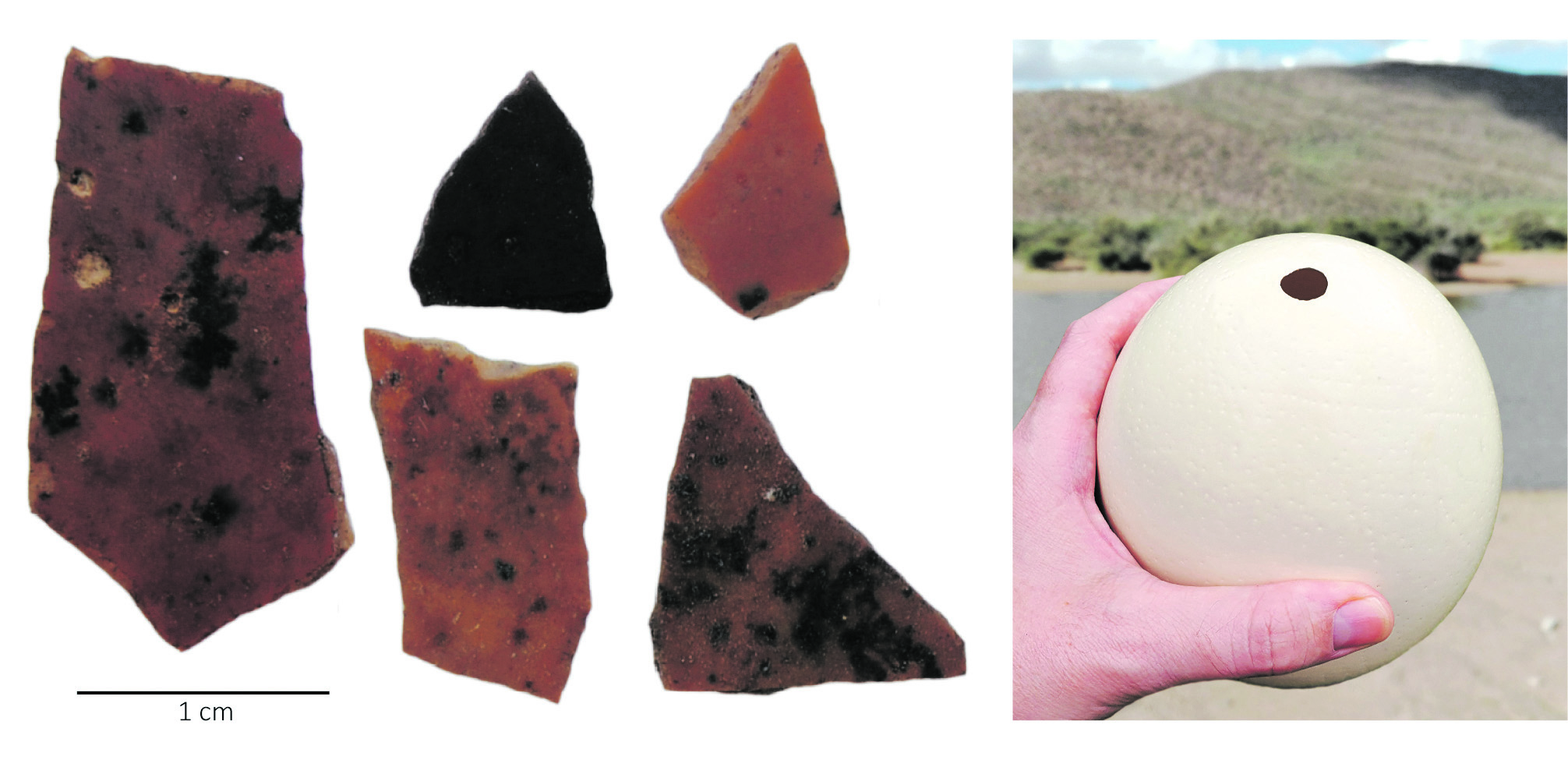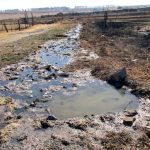168: OUR BURNING PLANET
South Africa wasn’t always a land of thirst

In an effort to ‘decolonise’ the desert, an all-women South African team has contributed to a global study offering new theories about early humans.
First published in the Daily Maverick 168 weekly newspaper.
What would it be like to enjoy a cup of rooibos with your direct ancestor, one fine afternoon, some 1,050 centuries ago? If you could understand one another, what would you say? Other than being an obvious curiosity, would an apparent proto-brain – forged among the punishing sands of the searing Kalahari – have anything at all of enduring interest to offer you, a tech-savvy member of contemporary Homo sapiens?
Now new findings on the lives of early humans argue it is possible to flip that script: instead of tea, imagine a woman handing you an ostrich shell. It is not filled with water sourced from scrapes of earth, but brimming with liquid gold from a stream. This water stream, and several others like it, gush out of the thundering falls, here in the ancient heart of a wet Kalahari.
Something fascinates you even more than the cascading waters of a land once thought of as bone dry. On her person, the woman – in health as rude as the water itself – reveals a crystal-filled pouch. A sign, perhaps, of an intricate mind using the beauty of things to celebrate its sense of self? Or to broker access to a metaphysical experience?
This thriving, if theoretical, Eden and its inhabitants are brought to life in findings published this week in the journal Nature by an international team of scientists. Led by Jayne Wilkins from Australia’s Griffith University, the team includes University of Cape Town (UCT) geologist Dr Robyn Pickering and her students: PhD candidate Jessica von der Meden, master’s student Wendy Khumalo and honours alumna Amy Hatton.

Wendy Khumalo with the excavation team. Credit HERI

Jessica von den Meden with Tufa formations. Credit:HERI
Pickering directs UCT’s Human Evolution Research Institute (HERI), formed about five years ago, and says these new artefacts are evidence of “complex human behaviour” – the inland counterparts of similar objects, and behaviours, previously traced to South Africa’s coastal regions to about the same period in the Middle Stone Age.
Indeed, about 105,000 years ago, Ga-Mohana Hill in the Northern Cape’s southern Kalahari may have been “home to modern Homo sapiens, who sheltered among waterfalls, stored water in ostrich eggshell containers and collected beautiful crystals”.
Braving what is today a famously unforgiving desert environment, it was half a decade ago that Pickering and her fellow scientists first asked something of a high-risk question: is there evidence of human life to be found in new locations of these patchily dated parts? Could this even challenge long-held beliefs about the origins of modern humans?
In an archaeological layer flush with stone tools, and burnt and butchered animal bones, their quest turned up the virtually unthinkable: ostrich eggshell fragments, calcite crystal caches and river-associated tufa deposits (freshwater carbonate) – the latter is proof, Pickering and her colleagues assert, that our early ancestors flourished in a “water-rich Kalahari”.
“This is a story of water in what we now know as a dry landscape, and of human ancestors who exploited the landscape, not only to survive, but thrive,” Pickering declares.
There is no small irony to this assertion. The “Kalahari” is, after all, known to be so inhospitable, its name is drawn from a word that sounds like a dry throat: kgala, Tswana for “great thirst”.
Human evolution research in South Africa is well established, Pickering concedes, but these endeavours, and the decorative items they have turned up, are largely associated with iconic sites such as Blombos Cave and Pinnacle Point in the Western Cape. These are additional, equally romantic, versions of our past, underpinning a narrative of early humans reliant on the ocean’s bounty.
Scholars and enthusiasts of the human timeline might thus be forgiven for assuming the movement of South Africa’s early first people was limited to these coastal parts, but Pickering, her all-women student team and other authors on this study suggest useful new dimensions.
“We’re showing a record of water in the rocks that not only matches the archaeological record but also provides evidence of a crucial resource for the people living at Ga-Mohana,” says Von der Meden, the PhD candidate. By analysing the tufa formations, she found proof of “abundant water” on this landscape. She dated the rocks to between 110,000 and 100,000 years ago – this echoes the same time that humans were living here.
Fortified with not a little grit, Pickering notes, they pushed ahead with these archaeological fortunes: Hatton, the honours alumna, worked with the rest of the crew to dig up the ostrich eggshell fragments. These may have been treasured water containers – ghostly discards surviving the silent, sand-swept aeons before being found by a modern band of deep-time curiosity seekers.
“This is the earliest evidence for human-collected ostrich eggshell in the Kalahari,” Hatton points out.
“Our findings mean we need to avoid overly simple models for the origins of our species,” explains Wilkins, who was affiliated with UCT before joining Griffith University. Wilkins and the SA team worked with Austrian, Canadian and UK institutions. “And it’s important to invite collaboration with diverse and young scientists to examine the many, largely understudied regions involved in shaping who we are today.”
It may come as a surprise to encounter a theory that paints the interior of South Africa – a critical source of early human and palaeontological finds – as “largely understudied”.
Dating back several million years, the record of human evolution in South Africa is “almost unparalleled in the world”, Pickering acknowledges, but she contends that this field has been dominated by “foreign white men” since Raymond Dart, a Johannesburg-based Australian, first described the hominin Taung skull in 1925. The anatomist showed that Africa, not Eurasia, was the cradle of the proto-human biography.
However, this new Nature study dovetails with her attempts as HERI director to help “transform” the field of human evolution and “decolonise” what she describes as dated views of the region’s landscape.
“We want to grow the next generation of great South African palaeoanthropologists – give people a safe space where they can do their science in a supportive environment,” she says, and adds: “There’s this narrative that Africa is empty and people were ‘primitive’. That’s not the case at all… We found beautiful hand axes. Reconstructing how these tools were made, it’s really complex. About 100,000 years ago these tools were the equivalent of the iPhone.”
The geologist explains she gave Khumalo, Hatton and Von der Meden notable autonomy, priming the budding researchers to collect their own samples, note their own observations and animate a story from the findings “largely on their own”.
Her initiative has paid off: as Pickering points out, it is almost unheard of for students to be published in Nature, the gold standard of scientific publications.
“Their work contributes crucial pieces of the puzzle,” says Pickering, while Von der Meden notes that the study gave her “the opportunity to see a real archaeological excavation in action”.

ExcavationsAtGHN.Photo:HERI

Ancient and modern Ostrich egg shell.Photo:HERI
By producing an all-women coterie bold enough to challenge a tough crowd – the archaeological establishment – Pickering’s entrepreneurial vision is delivering something else she wants HERI (pronounced “hairy”, she says) to be known for: breaking down what she calls male-dominated, “rocks for jocks” barriers.
When seen through human eyes, the study’s time period feels staggeringly large. Yet, 105,000 years are a blink of a geological eye.
We are now in the Anthropocene, bringing unmatched, human-wrought change – reading the past can provide critical data about human adaptability to Earth’s shifting systems.
Suggesting years more fieldwork, there are no cheap answers, says Khumalo.
“Multiple systems such as El Niño, changing sea-surface temperatures and complex Indian Ocean dynamics” may have worked together “to produce past rainfall in the region. The rainfall in the field area is governed by complex systems which, in the past, could result in higher precipitation in an area we know of today as very dry,” Khumalo told DM168.
“This shines the light onto inland sites that record early human occupation and offers context to a different environment previously excluded from the narrative.” DM168
This story first appeared in our weekly Daily Maverick 168 newspaper which is available for free to Pick n Pay Smart Shoppers at these Pick n Pay stores.






















Most enjoyable article. Probably the best of the day by DM. To get a thorough and deep understanding of who and what Homo Sapiens truly is, it is vital to really dig deep into the past. We often get so caught up in the events of the day that we lose much needed perspective. Great efforts by the younger generation to keep asking – and looking – for answers.
Engrossing stuff … with an attitude!